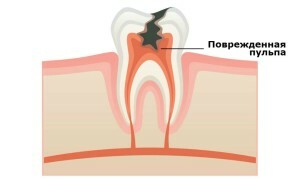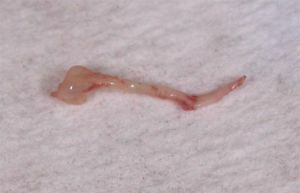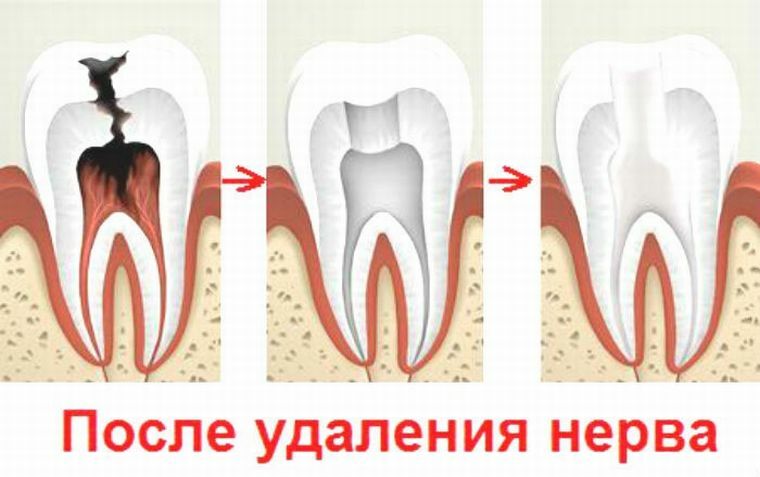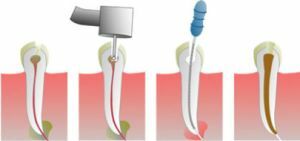 The human tooth has a complex structure. You might think that the tooth is only a visible part - a bone, but this is only partly true.
The human tooth has a complex structure. You might think that the tooth is only a visible part - a bone, but this is only partly true.
The top layer is covered with enamel, under which is hidden the dentin and the pulp, passing along the whole root, going deep into the gum. The pulp has a loose fibrous-vascular structure, and in the people it is called the nerve of the tooth.
This element reacts to thermal stimuli: acidic, hot, salty, cold. If during the dental procedure the doctor decides to remove the pulp, the tooth automatically loses its blood supply and is no longer alive.
The mineralization process also stops. Further, the destruction of the tooth begins: resistance to external stimuli decreases, the enamel becomes thinner and darker.
From the above, it can be concluded that pulp plays an important role in metabolic processes and tooth life.
Contents
- Indications for nerve removal
- Setting of dental crowns - to remove the nerve or not?
- Sick or not - that's the question
- Modern pulp removal technique
- Proper nerve preparation and removal
- Possible complications and consequences
- What can and can not be done after the procedure?
- Causes of pain after nerve removal
- From practice
- Question price
Indications for nerve removal
If a person has acute toothache or, conversely, for a long time the gum "noet", you should consult a dentist.
At the appointment, the doctor will determine whether the patient needs to remove the nerve of the tooth. Often, if the reception is conducted by a qualified specialist, then even at the slightest opportunity, he will do everything to save the nerve or perform its partial removal.
In what cases is the nerve removed from the tooth: 
- getting a mechanical injury to the tooth;
- need to correct the errors of the previous intervention;
- treatment of deep carious lesion;
- need for prosthetics.
Sometimes the patient does not feel pain or discomfort, but during a preventive examination the doctor recommends performing a tooth nerve removal. The reason for these appointments is one - chronic pulpitis, which does not provide other treatment and proceeds without symptoms.
Setting of dental crowns - to remove the nerve or not?
When treating teeth by installing crowns, a person may be wondering about the need to remove the nerve of the tooth.
Here, both a positive and a negative decision can be taken, depending on the initial condition of the oral cavity. If the tooth is almost completely destroyed, then the measure to remove the nerve is mandatory.
The qualification and practical experience of the attending physician plays an important role in this matter. Before the installation of metal-ceramic crowns, preparation of the tooth surface( cutting) is performed.
If the doctor is inexperienced, when heating or deep removing the surface layer, the nerve can be touched, which will lead to an attack of acute pain, so it is better to remove it.
In addition, with this method of treatment is likely that over time the tooth will begin to hurt under the crown and then remove it will be more difficult.
It hurts or not - that's the question
About 10 years ago it was even frightening to think about the procedure for removing the nerve. Modern medicine offers various painless ways to perform surgery.

On the photo the removed nerve of a tooth
The most widespread among them is the injection of an anesthetic into the gum. The duration of the procedure is no more than 45 minutes.
In this case, if the patient is afraid of pain from puncturing the gum, he will be asked to kill the nerve by applying a special paste, after which he will not feel anything.
Doctors recommend not using painkillers for acute pain, but immediately seek help. This is due to a decrease in the effectiveness of anesthesia analgesics.
Modern pulp removal technology
Do not be afraid of a dental office. In modern conditions, the patient will not feel pain during or after the procedure, not after it.
Initially, the doctor will inject the anesthetic drug in the gum injection, wait for the numbness of the working area, after which he will prepare a carious dentin with a special drill. This he opens access to the nerve.
When the passage is open, with the help of a thin, string-like instrument, pull out the pulp, and in the end will seal all the channels and moves. In the testamentary stage, a filling is applied to the crown part of the tooth.
There is a technique for partial removal of the dental nerve. If in the first case the tooth is considered dead, then this way it will remain viable.
However, it is performed only when the upper part of the tooth is damaged, when the process does not penetrate deep into the tooth. The doctor opens the crown part of the tooth, cleans the affected areas and cuts off the upper part of the pulp.
Correct preparation and removal of the nerve
Removing the nerve of the tooth - this is a small, but also an operation, and therefore requires careful preparation. Before the procedure, the doctor will necessarily perform the following:
- will conduct a patient interview( anamnesis);

- will examine the oral cavity and identify the affected tooth;
- , if necessary, will assign an X-ray;
- followed by anesthesia;
- isolates the work area;
- tooth is opened and cleaned from all, even the smallest areas with impregnations of caries.
When the zone is prepared, the physician will begin the procedure of nerve removal, having previously dried and rinsed the oral cavity.
Actions, after the preparatory procedures:
- to prevent saliva from entering the open canal, put cotton buds or put a special plate in the mouth;
- then enters the pulp extractor into the prepared channel( obsolete method) or the nerve is removed by expanding the file moves( spiral tool);
- disinfection is performed;
- filling with antiseptic;
- the seal( temporary) is established or if the doctor is assured of the actions, the constant is put.
The temporary filling is removed after 7 days.
How the nerve is removed from the tooth - video from a specialist:
Possible complications and consequences of
If the procedure for removal of the nerve of the tooth is performed by a specialist with low qualifications or with little practical experience, there is a risk of complications.
The most common are:
- bleeding from the canal;
- occurrence of repeated pain;
- breaks off part of the tool and stays in the channel.
Bleeding may occur during any medical intervention. Often, doctors quickly cope with this complication and stop the blood.
When the procedure is completed and the patient is already at home, he may feel pain attacks. This is normal, if not continued for a long time. For a long period of time, the channel will need to be re-opened and disinfected.

What can and can not be done after the procedure?
After the procedure, each doctor will give the patient individual advice. To general advice, the following can be attributed:
- do not exercise for the first 2 hours;
- should not be eaten for 3 hours after removal to prevent infection or injury to the tooth;
- avoid the use of solid products 3-5 days;
- do not take alcohol and do not smoke( to avoid irritation of the mucosa);
- perform the rinsing procedure with antiseptics within 24 hours after removal of the nerve.
Causes of pain after nerve removal
When a person has gone through a nerve removal procedure from the tooth, he may notice some discomfort or pain in the area of the intervention.
This is considered the norm, because the surrounding tissues, for example, the gums, were injured and sometimes injured. Gradually, the pain will go away.
It is also considered the norm to be sensitive to thermal irritants or when touching, pressing, for example, during chewing food.
The only thing that should alert a person is a sharp pain. Her appearance speaks of either a medical error( described above) or an organism's reaction to anesthesia-allergies. Also, the cause of the pain is infection.
From the practice of
From the responses of patients who have been removed nerve of the tooth.
About 5-6 years ago the tooth became ill, and its treatment was required. I do not even know why, because of laziness or for reasons of economy, I went to a public hospital( this was the biggest mistake of my life).The experience of doctors at the lowest level.
I thought that the procedure would go quickly and smoothly, because once I had already removed the tooth( laid arsenic) and everything was fine. But not at this time. The doctor drilled the tooth and pulled the nerve without anesthesia, it was very painful. So it's better to think 10 times in which hospital to go.
Alexey, Naberezhnye Chelny
Never experienced fear of dentists and when I had to remove the nerve without any thought went to the doctor. There I was made a ukolchik, drilled and got a nerve, then sealed. Time spent no more than half an hour. I applied to a private clinic, paid a little more, but the doctors know their business.
Olga, Tyumen
Price issue
 Immediately call a clear cost of removing the nerve of the tooth will not be able to any doctor. This is due to the fact that pricing involves several factors: the status of the institution, the amount of work, the level of tooth damage, the amount of material used, and so on.
Immediately call a clear cost of removing the nerve of the tooth will not be able to any doctor. This is due to the fact that pricing involves several factors: the status of the institution, the amount of work, the level of tooth damage, the amount of material used, and so on.
You can only name the approximate price. In public institutions, it starts from 300 rubles, in private from 1500 rubles( depending on the region).
The procedure for the removal of the nerve of the tooth should be trusted only by qualified specialists and never try to fulfill its home conditions. If an experienced doctor is involved, the patient will not feel pain, and the tooth will stay healthy.
